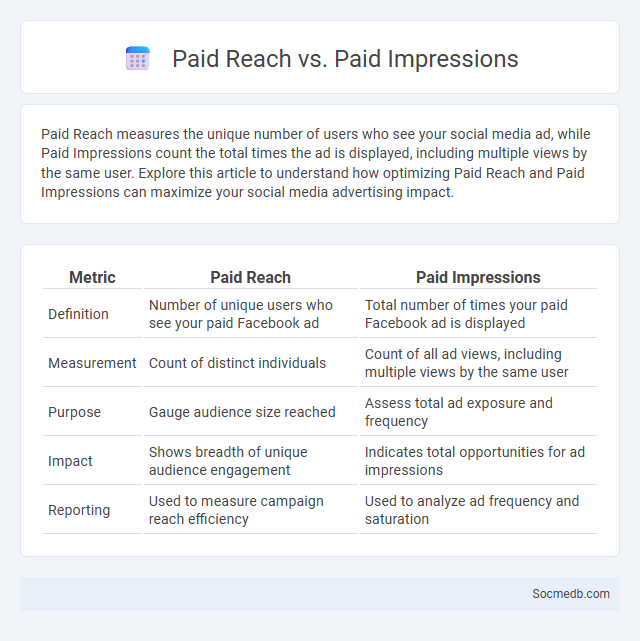
Photo illustration: Paid Reach vs Paid Impressions
Paid Reach measures the unique number of users who see your social media ad, while Paid Impressions count the total times the ad is displayed, including multiple views by the same user. Explore this article to understand how optimizing Paid Reach and Paid Impressions can maximize your social media advertising impact.
Table of Comparison
| Metric | Paid Reach | Paid Impressions |
|---|---|---|
| Definition | Number of unique users who see your paid Facebook ad | Total number of times your paid Facebook ad is displayed |
| Measurement | Count of distinct individuals | Count of all ad views, including multiple views by the same user |
| Purpose | Gauge audience size reached | Assess total ad exposure and frequency |
| Impact | Shows breadth of unique audience engagement | Indicates total opportunities for ad impressions |
| Reporting | Used to measure campaign reach efficiency | Used to analyze ad frequency and saturation |
Understanding Paid Reach: What Does It Mean?
Paid reach on social media refers to the number of unique users who see your sponsored content or advertisements. It differs from organic reach by targeting specific audiences through paid promotion, increasing visibility beyond your existing followers. Understanding your paid reach helps optimize ad spending and improve engagement with Your campaigns.
Defining Paid Impressions in Digital Marketing
Paid impressions in digital marketing refer to the total number of times your advertisement is displayed on social media platforms through paid campaigns. These impressions are crucial metrics for measuring the reach and visibility of your ads to targeted audiences, helping you evaluate the effectiveness of your marketing budget. Tracking paid impressions enables better optimization of ad placements and enhances your overall social media strategy.
Key Differences: Paid Reach vs. Paid Impressions
Paid reach measures the unique number of users who see a social media ad, while paid impressions count the total times the ad is displayed, including multiple views by the same user. Understanding the distinction is crucial for campaign analysis, as paid reach helps gauge audience size and engagement potential, whereas paid impressions reflect ad exposure frequency and brand visibility. Marketers optimize paid reach to expand targeted audience engagement and use paid impressions to maximize ad recall and frequency.
How Paid Reach Impacts Campaign Performance
Paid reach significantly amplifies your campaign performance by targeting specific audience segments, ensuring your content reaches potential customers beyond organic limits. Leveraging advanced algorithms, paid reach increases engagement rates, drives higher conversion, and improves overall return on ad spend (ROAS). Optimizing paid reach strategies helps businesses maximize visibility and generate measurable results across platforms like Facebook, Instagram, and LinkedIn.
The Significance of Paid Impressions for Advertisers
Paid impressions on social media platforms directly increase the visibility of your advertisements, reaching a targeted audience more effectively than organic reach alone. By investing in paid impressions, advertisers can enhance brand awareness, drive higher engagement rates, and achieve measurable ROI through precise audience segmentation and analytics. Maximizing paid impressions ensures your marketing campaigns impact the right users at optimal times, boosting conversion potential.
Choosing Between Paid Reach & Paid Impressions: When and Why
Choosing between paid reach and paid impressions hinges on campaign goals: paid reach maximizes the number of unique users exposed to ads, ideal for brand awareness and product launches, while paid impressions concentrate on the total number of times ads are displayed, suitable for reinforcing brand messaging and retargeting. Paid reach is effective for broad audience targeting, increasing market penetration, and attracting new customers, whereas paid impressions benefit engagement-focused strategies, enhancing ad frequency to drive conversions and recall. Analyzing metrics like cost per thousand impressions (CPM) and cost per reach, alongside campaign objectives and audience behavior, informs the optimal allocation of budget to maximize ROI on social media platforms.
Metrics That Matter: Measuring Paid Reach and Impressions
Paid reach quantifies the number of unique users exposed to sponsored content, offering a clear insight into the campaign's audience size. Impressions measure the total number of times the paid content is displayed, capturing the frequency of exposure across platforms. Tracking these metrics allows marketers to assess ad visibility and optimize budget allocation for better engagement and ROI.
Optimizing Ad Spend: Reach vs Impressions Strategies
Maximizing your social media advertising effectiveness requires understanding the balance between reach and impressions. Reach targets unique users to expand your audience, while impressions focus on showing your ads multiple times to reinforce brand awareness and drive conversions. Optimizing ad spend involves allocating budget based on campaign goals, ensuring your message hits the right people without overspending on repeated views.
Common Mistakes When Interpreting Paid Reach and Impressions
Paid reach and impressions on social media often cause confusion due to their distinct meanings; reach refers to the number of unique users who see your content, while impressions count the total number of times the content is displayed, including multiple views by the same user. Misinterpreting impressions as unique reach can lead to overestimating your audience size and the actual impact of your ad campaigns. Ensure you analyze these metrics correctly to optimize your targeting and budget allocation effectively.
Best Practices for Maximizing Results with Paid Reach and Impressions
Maximizing results with paid social media reach and impressions requires precise audience targeting based on demographics, interests, and behaviors to ensure ads connect with the most relevant users. Utilizing A/B testing for ad creatives and copy optimizes engagement metrics such as click-through rates and conversion rates, directly impacting campaign ROI. Regular analysis of platform-specific analytics tools like Facebook Ads Manager or LinkedIn Campaign Manager enables data-driven adjustments that enhance ad frequency, reduce cost-per-impression, and improve overall campaign performance.
 socmedb.com
socmedb.com